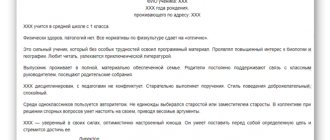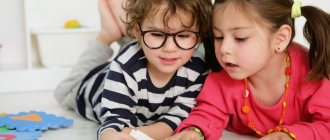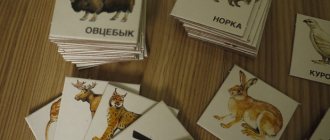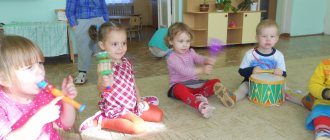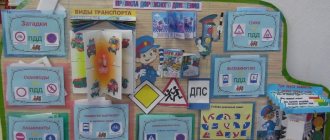Sample characteristics for a weak 9th grade student
| Characteristic 9th grade student ... (name of school) Tarasov Taras Tarasovich, Born 2000 |
Tarasov Taras has been a student of this school since the eighth grade (2015). Currently finishing 9-A grade. During his studies, Taras showed himself to be a poorly performing student with underdeveloped cognitive interests.
Taras is brought up in a complete socially disadvantaged family. Father, Tarasov T.P. Born in 1980, and mother, Tarasova O.I., born in 1981, unemployed, suffering from alcohol addiction for more than 5 years. The grandmother, L.G. Petrova, a pensioner, is raising the child. The family is characterized by low material income and lives in a one-room apartment that requires renovation. Taras is not sufficiently provided with the necessary seasonal clothing and school supplies. During the training, cases of theft from classmates (pens, pencils) were recorded.
Taras suffers from chronic gastritis and has contraindications to physical education.
Tarasov's educational activities are of little interest to Taras. He is passive in class and does not complete his homework. Reads poorly, academic performance is below average. He has a favorite subject, biology, in which he does not miss classes and actively participates in class work. Concentration and attention span are reduced. Abstract thinking is developed at an average level and can make logical conclusions. The development of voluntary memory is below average, it is difficult to remember educational material. Therefore, we can talk about the presence of the boy’s inclinations for successful education, but pedagogical neglect. From an early age, no one was involved in the development of the student’s cognitive processes.
Taras is a modest, insecure teenager. Shyness and inability to start a dialogue prevent him from establishing friendly relations with classmates. Most often he walks around sad. Does not take part in group activities, refuses to talk about himself.
The child requires psychological help and attention from social services for working with minors regarding the family situation.
Pattern to follow
The characteristics of a 3rd grade student with bad behavior include the following aspects:
- Student profile data (last name, first name, patronymic; date of birth; place of study, class; information about the student’s family).
- Data on the child’s physical development and state of health (information on morbidity, physical development and sports).
- Assessment of the level of educational achievements (low, satisfactory, good, high).
- Attendance at clubs and sports sections (school or outside of school).
- Characteristics of the student’s personal qualities (hardworking or lazy, responsible or irresponsible, active or passive).
- Active participation in school and class life (active, takes part in school competitions or not interested in school life).
- The student’s attitude towards himself (confident, modest, persistent).
- The student’s attitude towards others (closed, sociable, responsive, capable of compassion).
- The place it occupies in a group of classmates (has authority that is invisible to classmates).
- Parents' participation in raising a child.
- Conclusion.
The psychological and pedagogical characteristics of the student are compiled by the class teacher together with the school psychologist. The school psychologist includes the results of his observations of the student, diagnostics and tests performed.
When writing a profile for a student with bad behavior, pay attention to:
The emotional characteristics of his personality (the process of adaptation in the school community, the external manifestation of feelings, emotions, experiences). His strong-willed qualities (self-control, perseverance, discipline).
The reference is drawn up on the letterhead of the educational institution, signed by the teacher who compiled it, certified by the seal of the school and the signature of the director.
Characteristics for the average
A student’s good academic performance can be sporadic. In this case, the characteristics of the average student should indicate his indifference to school. Such children perceive lessons as a duty. They fulfill the teachers’ demands, participate to some extent in the work of the class, and sometimes even become active. However, sometimes this is done only in order not to attract the attention of adults and to avoid trouble. Such a character trait should be noticed by the teacher and indicated in the description of the personality.
As a rule, average people are completely confident that school and lessons are a boring and uninteresting activity that only adults need. Sometimes such children study only for the sake of obtaining a satisfactory assessment of their knowledge, asking the teacher to give them “at least a C.” Such students lack educational motivation, which harms their moral education. All this should be reflected in the characteristics given by the teacher. Knowing this, the new teacher will strive to increase the teenager’s extracurricular motivation to develop his cognitive interests and awaken the desire to expand and deepen his knowledge.
For a student with a low level of knowledge and performance
Nikita Kornilovsky has been studying at the State Institution “KSOSH No. 2” in Kirov since the 1st grade. Throughout his time at school, he showed such qualities as laziness and indifference to the educational process. Does not show due attention to the proposed educational material, is distracted by extraneous activities and ignores teacher comments. He is more interested in communicating with his classmates. Passive behavior in the classroom leads to poor academic results. Doesn't complete homework assignments, but is a master at copying.
Doesn't miss classes for no reason.
Shows a certain interest in humanitarian subjects, loves poetry and history.
Has the necessary work skills, but is not proactive enough to apply them. Gives greater priority to participation in class and school social events.
Loves attention from the outside, demands respect for himself and his opinion. In a conversation he may use obscene words, considering this the norm of behavior.
He has a significant level of athletic training and goes to the gym. Does not accept bad habits.
This is also important to know:
How to write a profile for a student who has completed an internship as a teacher at a preschool educational institution
He is friendly with his peers and enjoys authority. He is not always polite with elders. Does not tolerate injustice.
Lives with his father, mother and younger brother, whom he cares for very much. Parents regularly appear at school and communicate with the class teacher. They are actively trying to improve Nikita’s knowledge level.
Characteristics of a difficult teenager to the police from the class teacher
Andrey Grigoriev has been studying in the 10th grade of the State Institution “Secondary School No. 13” in Arkhangelsk since September 2020. During an incomplete semester of study, he established himself as a habitual truant. Periodically appears in classes, but treats the study itself with complete indifference. Doesn't do homework.
This is also important to know:
How to write a reference for a doctor: samples
In a group, the teenager communicates little, has difficulty communicating with classmates, and is friendly towards younger children. Due to the lack of initiative and leadership ambitions, he does not try to improve his position.
Andrey is neat and takes care of his appearance. When expressing his own opinion, he is quite modest, but stubborn. Convincing a boy of anything is quite difficult. However, the student has a low level of self-esteem, which allows the class leaders to lead him.
Andrey is actively involved in extracurricular activities that interest him (classes, gym). Participates exclusively in the sports life of the school, showing no interest in other social events. He may refuse the assignment given to him or not complete the job. There is no labor initiative on his part.
Caught smoking.
Since October 1, 2020, he has been registered with a social teacher and psychologist at school.
Lives in a single-parent family with his mother. She cannot pay due attention to raising the child, since it is difficult to keep track of Andrei’s movements. Mom tries to keep in touch with the school administration and the class teacher.
Sample characteristics
Psychological characteristics
Student ___________class secondary school №______ FI_________ Date of birth_________________ Home address__________
1
.
The type of difficulty
is explained by: gaps in mastering ethical knowledge, unformed moral ideas, lack of skills of adequate behavior, personality changes associated with distorted ideas about relationships with others, organic disorders of the nervous system, mental instability, increased affectivity, disinhibition of drives.
2.Psychophysiological features
a) stable extrovert: sociable, open, talkative, accessible, carefree, lively, carefree, prone to leadership;
b) unstable extrovert: touchy, restless, aggressive, excitable, changeable, impulsive, optimistic, active; c) stable introvert: passive, cautious, reasonable, peaceful, reserved, reliable, even, calm; d) unstable introvert: gloomy, anxious, pessimistic, withdrawn, uncommunicative, quiet; Personality type (according to Eysenck) Characteristics of the type:________________________________________________________________ ___________________________________________________________________________________ ___________________________________________________________________________________ ___________________________________________________________________________________ 3. Emotional-volitional sphere.
Type of character accentuation (according to Shmishek): hyperthymic anxious dysthymic pedantic emotive stuck demonstrative exalted cyclical excitable
4. Motivational-need sphere. Needs:
for physical improvement, spiritual improvement, for work, for friendship, for emotional closeness with peers, for respect and support from adults, from peers, for entertainment, for comfort, for leadership, for helping others, for achievement high results in activity, in autonomy, in prestige, sexual needs.
5. Features of school maladaptation:
a
) study
: low learning ability with positive learning motivation, satisfactory or high learning ability with persistent indifference or a negative attitude towards learning, low level of learning ability with a negative attitude towards learning;
b) psychological reasons: lack of formation of methods of educational activity, insufficient development of mental processes, inadequate use of individual typological characteristics; c) labor and social activity:
low (high) labor (social) activity, inability to engage in systematic, purposeful, intense activity, low (high, situational) performance, low (high) sense of responsibility, inability (ability) to complete the work started , initiative (lack of initiative), low (high, average) organizational skills;
d) psychological reasons: defects in education, undeveloped work skills, underdeveloped volitional qualities, lack of interest in work. 6. Anxiety:
a) general (according to Prihozhan): high, increased, normal, low;
b) personal: high, increased, normal, low; c) interpersonal: high, increased, normal, low; d) school (according to Phillips): high, increased, normal, low. High level by factors: fear of knowledge testing situations, fear of not meeting the expectations of others, frustration of the need to achieve success, conflicts with teachers, fear of presenting oneself. 7. Intellectual level (according to Roven):
Level of intellectual development: high, average, low.
Social characteristics.
1. Position in the group
: leader, preferred, isolated, acceptable, rejected.
2. Attitude towards the group
: positive, negative, indifferent.
3.
Part of
the group
________________________________________________________________ ________________________________________________________________________________
4. Reference group
________________________________________________________________________________ ________________________________________________________________________________
5. Violation of communication and behavior:
a) age-related situational and personal reactions: refusal, opposition (active, passive), imitation (imitation), compensation (desire to eliminate weakness), overcompensation, emancipation (refusal of adult care), grouping with peers, sexual desires, hobby reaction, dysmorphoreaction (fixation on appearance), reflexion reaction (fixation on the inner world); b) dominant maladjustment syndromes: distrust of new people, things, situations; depression; withdrawal; anxiety towards adults and peers; hostility towards adults and peers; lack of social normativity; social deprivation; restlessness; emotional stress; neurotic symptoms; unfavorable environmental conditions; advanced sexual development; mental retardation; learning difficulties; diseases and organic disorders; physical defects. Disadaptation manifests itself to a minor (significant) extent. It is situational (chronic) in nature. The child is on the verge of clinical disorders and needs (not) the help of a neuropsychiatrist. c) the nature of deviation: immoral, delinquent (non-criminal offenses), criminal behavior. Reasons: heredity, social. development situation, personal crisis, conflict, failure in leading activities, inadequate self-esteem, lack of authority, state of passion. d) type of behavioral disorder: absenteeism, running away, theft, petty speculation, fights, drinking alcohol, drugs, substance abuse, smoking, deviation of sexual behavior (masturbation, exhibitionism, group sex, fetishism, homosexuality), suicidal behavior (demonstrative, true, affective ), fears (phobias), obsessions (blinking, twitching, nail biting, thumb sucking, fear of infection, repeated movements, words), verbal disorders (foul language, pathological lying), gambling, computer addiction, increased aggressiveness, increased anxiety , hyperactivity, autism, increased conflict, negativism, increased stubbornness, impulsiveness, selfishness, weakness of will, affectivity.
6. Family relationships:
a) type of family according to educational potential: educationally unstable (overprotection); educationally weak with loss of contact with the child and control over him; educationally weak with an aggressive-negative atmosphere; marginal (with alcoholic, sexual, drug demoralization); delinquent; criminal; mentally aggravated, neglect, child abuse b) cultural level of the family: high average, low. c) relationships: trusting, equal, conflicting, alienated. d) parental authority: high, low, insufficient, low. e) style, methods, techniques of education: pedagogically correct, incorrect, inadequate. Unity (lack of unity) of educational influences of family members. f) the social regime and family climate are satisfactory, positive, unsatisfactory. g) level of fulfillment of school requirements: high, satisfactory, insufficient, low, extremely low. The family is (not) a stabilizing factor for the child.
Additional information:
Compiled by a psychologist:
Psychological characteristics of a student in class _ “_” __________________
I. General information about the child.
1. Full name - ____________________, date - __________, age at the time of the study - 9 years. 2. Place of residence - ______________________________ 3. Information about parents - _______________________________, father A__________________________________________________ Grandparents are pensioners, they live together with their daughter and grandson in a two-room apartment. 4. School No._, class-_ “_”.
I I. Methods for studying a child’s personality:
PROTOCOL OF PSYCHODIAGNOSTIC EXAMINATION OF A STUDENT _ "_" CLASS __________
- Anxiety test (R. Temple, V. Amen, M. Dorki)
Purpose: To study and evaluate the anxiety of a child of primary school age in typical life situations. Who conducted it: 5th year student of the Faculty of Education and Science A.M. Sinyakova. Date: 10.17.2006 As a result of the study, it was revealed: -In 100% of situations that have a positive emotional connotation (Playing with younger children, Playing with older children, Child with parents) (...) has an emotionally positive experience. In 100% of situations with a negative emotional connotation (Object of aggression, Reprimand, Aggressive attack and Isolation) (...) has an emotionally negative experience. These data may indicate that the child gives a positive or negative assessment of his emotional background adequately to various life situations. In 57% of situations that have a double meaning (4 out of 7), we can talk about the presence of (...) negative emotional experience. These situations are: Going to bed alone, Washing up, Picking up toys and Eating alone. - The highest level of anxiety in (...)a manifests itself in situations that simulate relationships that simulate everyday activities (Dressing. Going to bed alone. Washing up. Collecting toys. Eating alone). — (...) has a high level of anxiety, as evidenced by the child’s anxiety index (percentage ratio of the number of emotionally negative choices to the total number of drawings): 57%.
Protocol of psychodiagnostic examination
of Student _ “_” class ___________
- “LADDER” METHOD V.G. Shchur
Goal: to determine the characteristics of the child’s self-esteem (as a general attitude towards himself) and the child’s ideas about how other people evaluate him. Who conducted it: 5th year student of the Faculty of Education and Science A.M. Sinyakova. Date: 10.17.2006 As a result of the study, the following was revealed: - the child’s attitude towards himself is positive, self-esteem is adequate, positive (placed himself on the 4th of 6 steps. - he perceives the attitude of other people towards the child quite differentiated: (...) believes, that close adults (mother, father, grandfather, grandmother, friend, and also teacher) treat him differently. The child believes that his mother will put him at the very top of the ladder, but he puts himself a little lower - on the third step from the top. This is may indicate that (...) he feels strong support from the most significant adults. - the child’s self-assessment from the teacher is lower than his own, the child’s explanations about this - the teacher’s dissatisfaction with “bad behavior and low grades”, which indicates that (...) is able to take a rather critical approach to assessing himself as an individual.
PROTOCOL OF PSYCHODIAGNOSTIC EXAMINATION
OF STUDENT _ "_" CLASS ______________
- School motivation questionnaire N.G. Luskanova
The purpose of the diagnosis: to study the level of school motivation. Who conducted it: 5th year student of the Faculty of Education and Science A.M. Sinyakova. Date:10/17/2006
The study revealed:
Based on the diagnostic data, a low level of school motivation was revealed in (...), as evidenced by the unwillingness to attend school, during lessons he often engages in extraneous activities and games, and experiences serious difficulties in learning: he cannot cope with educational activities, he experiences problems in relationships with the teacher. School is often perceived by him as a hostile environment, therefore (...) may sometimes show aggression, refuse to complete tasks, or follow certain norms and rules.
PROTOCOL OF PSYCHODIAGNOSTIC EXAMINATION OF A STUDENT _ “_” CLASS (…)(…)A
- CATTELL'S PERSONALITY QUESTIONNAIRE FOR JUNIOR SCHOOLCHILDREN
The purpose of the diagnosis: to study the level of school motivation. Who conducted it: 5th year student of the Faculty of Education and Science A.M. Sinyakova. Date: 10/17/2006 The study revealed: -High level of expression of Extraversion (9 points), which characterizes the child as an emotional, open, sociable, sympathetic child. -High level on the Emotional Inexcitability scale (8 points) - characterizes (...) as impatient, easily excitable, with instability of attention, increased motor activity. — Low level of Self-Control (3 points), which is a sign of the inability to control one’s behavior.
Other diagnostic methods and forms used in the study:
- CONVERSATION WITH A PSYCHOLOGIST, CLASS TEACHER
- CHILD MONITORING
- STUDYING THE DOCUMENTATION AVAILABLE FOR THE CHILD (...) is registered with a psychologist as a child with behavioral characteristics)
III. General characteristics of the child’s relationship system in the classroom. Social contacts:
- with peers. Communication status: active. In the 3rd grade, there was a dependence on classmate Vladik Bogdanov (a child with pronounced aggressive behavior). At the time of the examination, he stopped his friendship with Bogdanov. Establishes relationships with all classmates, but has close friendly relations with the guys from the yard. Prefers friends who like to play around, run, and play pranks. The school community is often perceived by him as a hostile environment, therefore (...) can sometimes show aggression.
- with adults. May exhibit a variety of communication signs: from subordination and shyness to impudence and impudence; reacts to teacher criticism passively and positively (understands the criticism, agrees with it, but does not correct shortcomings). Experiences problems in relationships with the teacher.
IV.
General characteristics of the student’s personal sphere. Characteristics of personality traits:
The child’s attitude towards himself is positive, self-esteem is adequate, the positive attitude of other people towards the child is perceived by him quite differentiated: (...) believes that close adults (mother, father, grandfather, grandmother, friend, as well as teacher) -they treat him differently. The child’s predicted assessment of himself by the teacher is lower than his own; the child’s explanation for this is the teacher’s dissatisfaction with “bad behavior and low grades,” which indicates that (...) is able to take a fairly critical approach to assessing himself as an individual. The student is emotional, sociable, impatient, and easily excitable. There is instability of attention, increased motor activity, and he cannot always control his behavior. Increased anxiety (...) manifests itself in situations related to everyday activities and routine moments. School motivation is not sufficiently developed, as evidenced by the reluctance to attend school, during lessons he often engages in extraneous activities and games, and experiences serious difficulties in learning: he cannot cope with educational activities, which is associated with insufficient development of voluntary attention. (...) enjoys drawing and plays football in the sports section.
PSYCHOLOGIST'S CONCLUSIONS:
(...) are characterized by such behavioral and personal characteristics as violation of discipline in lessons and during breaks, poor academic performance, low level of school motivation.
In this regard, it is RECOMMENDED that the child’s class teacher:
- draw up an individual work plan to support the family, taking into account the individual characteristics of the family situation; — Every quarter, visit the child at home in order to study living conditions and study the situation of relationships between family members. -monitor employment (...) during the holidays; -Relationships should be built on conviction, a calm, friendly tone of communication. Through personal example and repeated tactful repetition, instill (...) the rules of behavior in school life. Corrective work is recommended to develop self-control skills and skills of constructive interaction with peers. To provide knowledge on the rights of the child, the rights and responsibilities of schoolchildren, legal knowledge. Strictly monitor attendance and academic performance (…). -Establish a positive emotional background associated with school - under no circumstances compare the child with other children. Do not speak badly about the school, do not criticize teachers in the presence of the child, create in him a positive, positive attitude towards school. - Stimulate the educational and cognitive activity of children through: creating situations of emotional experience, creating situations of entertainment, situations of relying on life experience, situations of success in educational and cognitive activity. Date of research: 10/17/2006 Conducted by 4th year FSP and P student Elena Smarigo.
| Documentation of a school psychologist - Documentation (plans, reports, characteristics) |
| Author: Administrator |
| 01.03.2010 11:58 |
| Appendix 2 The psychological characteristics of a “difficult” student are written in two copies by a teacher-psychologist, one of which is kept in the deputy’s record card. director for IVR, the other - with an educational psychologist. Psychological characteristics of a “difficult” student ________________________________ (student's full name) Date of birth: Date of testing: The characteristics are written in free form and contain a description:
Educational psychologist ___________________ (full name, signature) |
Appendix 3
The psychological and pedagogical characteristics of the family are written in duplicate by an educational psychologist together with a social pedagogue. One copy is kept in the account card of the deputy. director for IVR, the other - with an educational psychologist.
Psychological and pedagogical characteristics of the family of a “difficult” child
________________________________ (student's name)
Date of birth: Date of testing:
The characteristics are written in free form and contain a description:
- family composition, education of its members, whether there was a breakdown of the family;
- stability of family relationships;
- the main causes of quarrels and conflicts;
- which family members are involved in raising children;
- style of upbringing in the family, whose opinion the child takes into account;
- organization of leisure time in the family;
- the educational psychologist describes the relationships in the family (according to the data of psychological and pedagogical diagnostics of intrafamily relationships).
Social teacher (describes the first 6 points)
___________________ (full name, signature)
Educational psychologist ___________________ (full name, signature)
Recommendations for interacting with “difficult” students
____________________________
(student's name)
To the social teacher:
_______________________________________________________ Familiarized with
_______________________ (signature)
To the class teacher: _______________________________________________________ Familiarized with
_______________________ (signature)
To parents: _______________________________________________________ Familiarized with
_______________________ (signature)
Subject teachers:
_______________________________________________________ Acquainted with
_______________________ (signatures of teachers in the subjects in which the child has difficulties)
To the Inspector of Educational Education: _______________________________________________________ Acquainted with
_______________________ (signature)
Administration:
_______________________________________________________
Acquainted with
_______________________ (signature) To the organizing teacher:
_______________________________________________________ Acquainted with
_______________________ (signature)
Appendix 5
The plan for correctional work with a “difficult” student is drawn up in quarters and includes specific measures for the correction of the following specialists: class teacher, educational psychologist, social teacher, subject teachers, teacher-organizer, deputy. Director for IVR, Deputy. Director of Internal Affairs, Inspector of Internal Affairs, librarian. In the “date” column, the specialist enters the planned date of the event; in the “completion mark” column, the date of the planned event or change in the plan is entered, if this event is postponed for some reason. Unplanned events are recorded in the appropriate column below upon completion in the section of the relevant specialist.
I APPROVED
Director of secondary school No. ___
_________________________
(full name, signature) __»_______________200_g.
PLAN
CORRECTIONAL WORK FOR THE 2nd QUARTER 200_-200_ OF THE SCHOOL YEAR
| Month | Executor | Corrective measures | date | Completion mark |
| November | Classroom teacher | |||
| Social teacher | ||||
| Educational psychologist | ||||
| Subject teachers | ||||
| Teacher-organizer | ||||
| IDN inspector | ||||
| Deputy Director of IVR | ||||
| Deputy Director of HR | ||||
| Librarian | ||||
| December | Classroom teacher | |||
| Social teacher | ||||
| Educational psychologist | ||||
| Subject teachers | ||||
| Teacher-organizer | ||||
| IDN inspector | ||||
| Deputy Director of IVR | ||||
| Deputy Director of HR | ||||
| Librarian |
[1]
[2][3][4][5][6][7][8][9][10]
Appendix 6
The program is compiled by the deputy. director for IVR, social teacher and educational psychologist for six months based on the psychological and pedagogical characteristics of the student, his family and the recommendations of the educational psychologist. The program includes the work of the class teacher, SPPS specialists, IDN inspector, subject teachers, and librarian.
I APPROVED
Director of secondary school No. ___
__________________________
(Signature, full name)
“_” _______________200__
CORRECTIONAL WORK PROGRAM (sample)
with a student of ____ class of secondary school No.___ in Minsk ____________________ (full name) for ___ half-year of the 200__-200__ academic year Date of the meeting of the pedagogical council - _________
| № | Corrective measures | Performers | Period of execution |
| 1. | Daily monitoring of attendance at training sessions. | Class teacher, social teacher | Constantly |
| 2. | Studying the features of the development of the emotional and personal sphere. | Educational psychologist | September October |
| 3. | Taking timely measures to prevent and overcome neglect in studies: -implementation of a differentiated approach to learning; - use of stimulating and organizing types of assistance during the lesson; -monitoring current progress and communicating information about it to parents. | Cl. head, subject teachers, deputy. Director of HR | During a year |
| 4. | Conducting individual correctional classes with elements of art therapy, developing the ability to analyze one’s own behavior and resolve conflict situations. Program “Labyrinths of my “I””. | Educational psychologist | November-December, once a week |
| 5. | Organization and control of attendance at stimulating classes in subjects in which the teenager has low performance (below “3”). | Cl. head, subject teachers, deputy. Director of HR | As needed |
| 6. | Involving collective creative activities in the preparation and participation: A) select a permanent assignment in the class, taking into account interests and inclinations; B) involve in conducting classroom hours and information hours; B) involve in the sports section; -library. | Cl. supervisor Social teacher Librarian Teacher-organizer | Within half a year |
| 7. | Visiting a teenager's family. Discussion with mother about problems of behavior and education. | Social teacher Kl. supervisor | 1 time per quarter |
| 8. | A series of individual correctional conversations with a teenager on the topic “Safe and responsible behavior” for the purpose of crime prevention. | Social teacher, Inspector of Internal Affairs | 2 times a month |
Deputy Director of IVR Teacher-psychologist Social teacher
Appendix 7
Filled out by a social teacher together with an educational psychologist based on the results of correctional work for the year. Stored in the student's record card.
RESULTS
of correctional work for the __half of the 200__-200___ academic year with a student _____________________
Psycho-pedagogical status at the time of drawing up the program:
Current problem of difficulties identified during the examination: _________________________________________________________________ Goal and task of correctional work: ________________________________________________________________________________ General assessment of the effectiveness of the work carried out: ________________________________________________________________________________ Pedagogical essence of the changes: ________________________________________________________________________________ General recommendations for further work with the student: ________________________________________________________________________________ Teacher-psychologist (fills out the first 3 points) ________________________________________________________________ Social teacher (fills out the last 2 points)______________________________________________________________ Deputy. Director for IVR______________________________________________________________
Program for diagnosing the personality of a deviant teenager
| Diagnostic techniques | date |
| Diagnostics of the cognitive sphere | |
| 1. “Shape recognition” | |
| 2. “Arrangement of numbers” | |
| 3. "Memory for numbers" | |
| 4. Methodology “Learning 10 words” by A.R. Luria | |
| 5. "Simple Analogies" | |
| 6. "Word Elimination" | |
| 7. “Identification of essential features” | |
| 8. “Finding numbers” (Schulte tables) | |
| 9. | |
| 10. | |
| 11. | |
| 12. | |
| 13. | |
| 14. | |
| 15. | |
| Diagnosis of personality traits and mental states | |
| 1. Smišek test | |
| 2. "Nonexistent Animal" | |
| 3. Phillips test | |
| 4. Test “Home. Tree. Man" (DCH) | |
| 5. Self-assessment scale of anxiety level by Ch.D. Spielberger, Yu.L. Khanin | |
| 6. SAN Questionnaire | |
| 7. CBS | |
| 8. Thomas test | |
| 9. Eysenck's method for determining temperament | |
| 10. Constructive drawing of a man from geometric shapes | |
| 11. Psychogeometric test | |
| 12. Test of humorous phrases (TUF) | |
| 13. | |
| 14. | |
| 15. | |
| 16. | |
| 17. | |
| 18. | |
| 19. | |
| 20. | |
| 21. | |
| Diagnostics of interpersonal relationships in a team | |
| 1. Sociometry | |
| 2. COE | |
| 3. Lutoshkin color relations test | |
| 4. Referentometry | |
| 5. | |
| 6. | |
| 7. | |
| 8. | |
| 9. | |
| 10. | |
| Diagnosis of family relationships | |
| 1. DIA questionnaire (Eidemiller, Justitsky) | |
| 2. ROD questionnaire | |
| 3. "Kinetic drawing of a family" | |
| 4. Methodology for diagnosing parental attitudes (A.Ya.Varga and V.V.Stolin) | |
| 5. “Kinetic drawing of a family” | |
| 6. Diagnosis of family relationships (questionnaire) | |
| 7. Typical family state | |
| 8. | |
| 9. | |
| 10. | |
| 11. | |
| 12. | |
| 13. | |
| 14. | |
| 15. | |
| 16. | |
| Diagnosis of vocational guidance | |
| 1. Map of interests “Do you love? Do you like it? | |
| 2. Differential diagnostic questionnaire “I would prefer” | |
| 3. Holland test | |
| 4. Tapping test | |
| 5. Method of express diagnostics of characterological characteristics | |
| 6. Measuring achievement motivation | |
| 7. | |
| 8. | |
| 9. | |
| 10. | |
| 11. | |
| 12. | |
| 13. | |
| 14. | |
| 15. |
Psychologist, Secondary School No. _____________________________________
(full name, signature)
